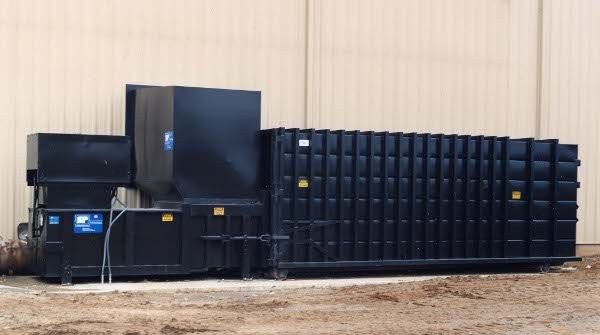
Balimoy/DSE, Inc. is a company in Florida that produces ammunition. Like most metal working facilities, Balimoy produces an overwhelming quantity of scrap metal chips and turnings that are saturated with cutting fluids. The company’s production department knows that this scrap steel, aluminum and copper is a valuable commodity in the recycling market and sells the metal by the container load to a local scrap metal recycler. However, the cutting fluids from production that are mixed in with the metal turnings were significantly reducing the value of the scrap.
Because the fluids are a contaminant, a large percentage would have to be removed to improve the asking price for the metal scrap. Balimoy’s traditional practices to remove fluid included the use of a centrifuge system, or the use of gravity for drainage. A centrifuge system works well, by spinning fluids out of metal, but are expensive, high maintenance and labour intensive. If scrap metal is allowed to sit in a pile or a container, a significant percentage of the fluids will drain out. This practice however, does not allow for efficient fluid collection and can result in a number of environmental ground contamination problems. Balimoy’s scrap is usually loaded in an open top container for pick-up by the recycling company.
This practice posed additional contamination problems from rain water. Plus, water in the container increases tare weight and reduces the amount of scrap metal that can physically be transported.
When Balimoy turned to SP Industries’ dealer Morrow Equipment, to look at its operation and contamination problems, Morrow approached the problem from the compaction angle. The scrap, steel and aluminum chips and turnings, they proposed, can be compacted into a closed container to improve tare weights and reduce contamination from rain.
The real problem for Balimoy was from cutting fluids mixed in with their scrap. SP Industries modified a CP-3002 industrial compactor and 40 cubic yard capacity compaction container to improve the run-off of fluids and devised a closed collection system to contain the fluids for reclamation.
The result was a cleaner, closed system that eliminated environmental ground contamination caused by the cutting fluids, and eliminated contamination of the material and cutting fluid from rain.
According to SP, without the rain contamination and with the collection of the cutting oil from the material, the value of the scrap greatly increased and Balimoy was able to negotiate a higher price per pound. Plus, the cutting oil that is reclaimed from the system is re-used in production, which in turn reduces production material costs. In addition, more material is compacted into the container to increase the tare weight and reduce the number of times the container has to be hauled.
Tower Automotive
SP Industries also provides metal recycling equipment for Tower Automotive, a large industrial automotive stamping operation in Eastern Michigan which produces a variety of metal components for cars and trucks. The parts range in size from small trim parts to hoods and door and side panels. During production, a large volume of scrap is created from trimmed components. The material that is used for these parts is a high grade #1 mill steel called “busheling” or “clip”. This material is highly sought by the scrap steel industrial market and consistently brings a substantial market price.
When Tower’s facility was originally built, an underground conveyor system was constructed that transferred the material from the production area to the scrap collection area outside. Once outside the clip was conveyed to an overhead system that loaded open top containers. Four open tops were arranged so that the two pivoting conveyors could load any one of the containers in a continuous operation. As the containers were filled, the salvage company would switch them out with empty containers, then transfer the material to the recycling facility. The four 80 cubic yard capacity containers would only hold 7,000 to 15,000 pounds of material each. These light loads resulted in a constant flow of trucks between the two locations.
When the salvage company turned to SP Industries’ dealer, Tom Stevens of Wolverine Recycling, to find a way to reduce the cost of equipment operation and labour, Stevens looked to SP Industries’ extensive line of industrial compactors for answers. His goal was to efficiently pack dense loads into compaction containers and to reduce the equipment and labour costs associated with the open top system.
Using the existing conveyor system, Stevens was able to place two compactor units back-to-back in place of two open top containers. One compactor can be loaded at a time. The flow of clip material is diverted to the other compactor when the full container is transported to the salvage yard, and a bar grate system helps to keep metal clips from working their way around the ram and interfering with ram movement.
Plus, pinning tunnels attached to the ram face allow the operator to pin the load in the container to reduce material fall-out when the container is pulled away from the compactor.
Both compactors are CP-6002-D, high density six cubic yard capacity units. They are raised and levelled for compaction above the container floor, and a steel bar grate system of 1-inch x 2-inch cold rolled steel bars is installed in the compaction chamber and on the ram to help prevent clip material from wedging around or under the ram. Two pinning tunnels mounted on the ram face are used to pin the load in the container to reduce material spills when the container is pulled away from the compactor. A top load hopper directs the material into the compaction chamber from the loading conveyor, then a programmable start system automatically starts the compactor when the compaction chamber is full.
To reduce the cycle time, both power units were upgraded to 50 hp/63 gpm units. An oil cooler was also added to maintain oil temperature. When the 70 cubic yard capacity push-out container attached to the compactor is full, the load is pinned and a closure door is closed over the compaction opening to prevent any small pieces from spilling during transport. This system packs a container in an average of six hours, and during certain production runs that have resulted in increased scrap volume, a container may be packed in as little as one and one-half hours. These loads, on average, weigh 50,000 pounds. The result is a greater than five to one compaction ratio.
The final outcome of the project at Tower Automotive is an efficient cost saving system that has substantially reduced the salvage company’s operating costs, increasing overall revenue. The new compaction system also allows the company to use its people and equipment more efficiently to improve service.



